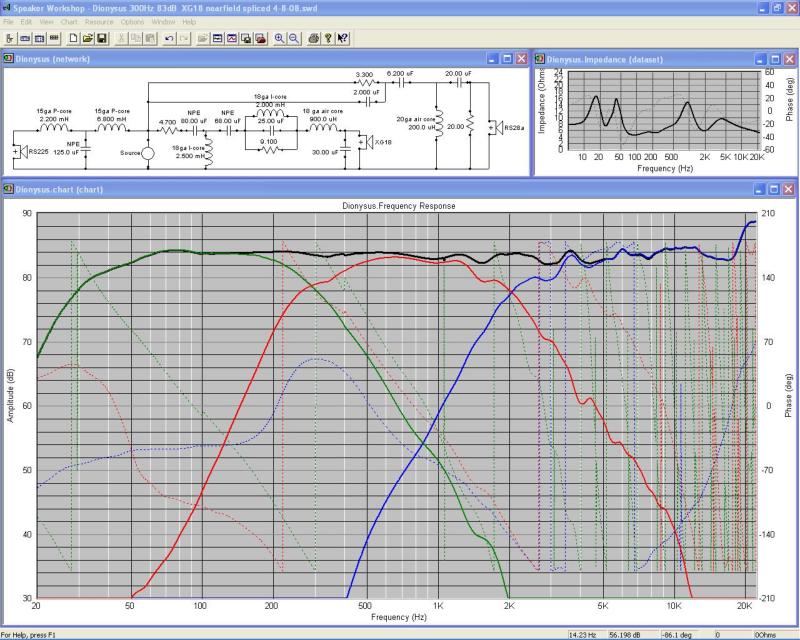

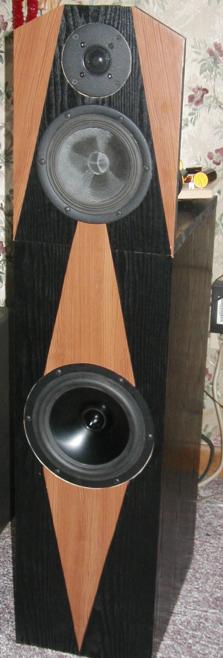
IntroductionThe Dionysus design is my first attempt at a dipole design. This is actually a hybrid dipole design because the Vifa XG18 is the only driver in the dipole configuration while the Dayton RS28A tweeter only radiates forward and the bottom end is covered by the Dayton RS225 woofer in a ported configuration. The lower woofer cabinet is actually the bottom half of my Daedalus design which I was never really happy with due to a lack of soundstage depth and the inability to separate instruments in the midrange region. I basically just removed the top cabinet and "wings" from the Daedalus design and made a new dipole panel for the XG18 and RS28a. The main problem with this design is that the Vifa XG18 driver is no longer available so unless you have an old pair sitting around or are able to buy a used pair you won't be able to build this design. Please don't ask me to redesign the crossover for a different midrange driver because it is very unlikely that a simlated design for a dipole driver will sound right, especially since it took me 2 months to tune the XG18 in this configuration.DriversDayton RS28A-4Vifa XT18WH09-08 Dayton RS225S-8 Cabinet DesignAs I said before, the Dionysus design uses the woofer cabinet from the Daedalus design along with a new top panel for the XG18 and RS28A. Below is a blueprint of the entire cabinet. The top, dipole panel is made from three boards including the baffle which is 14" tall, a baseboard that extends the depth of the woofer cabinet and a support board which runs through the center of the baffle with cutouts for the rear driver assemblies.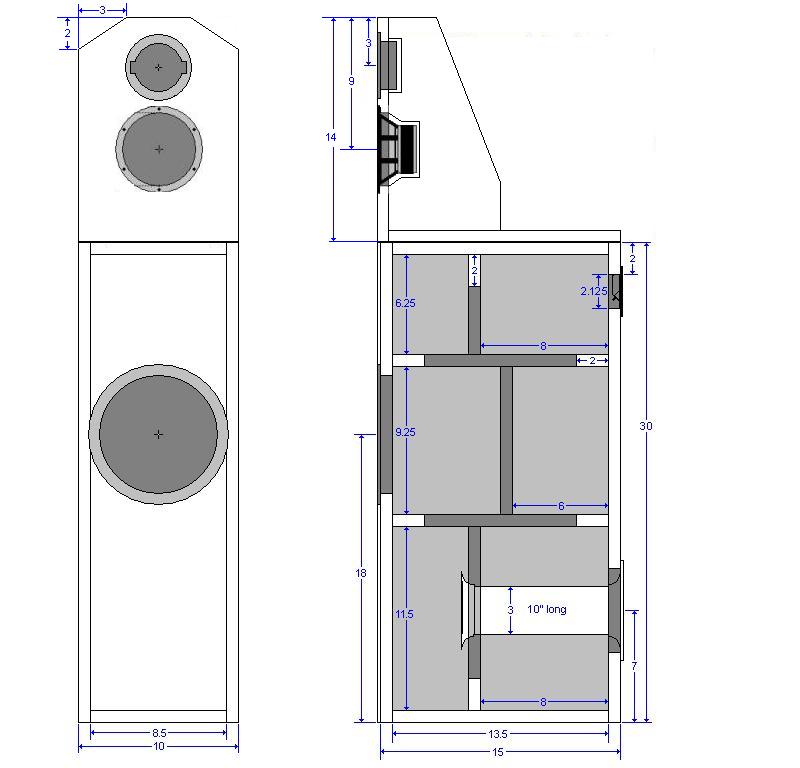 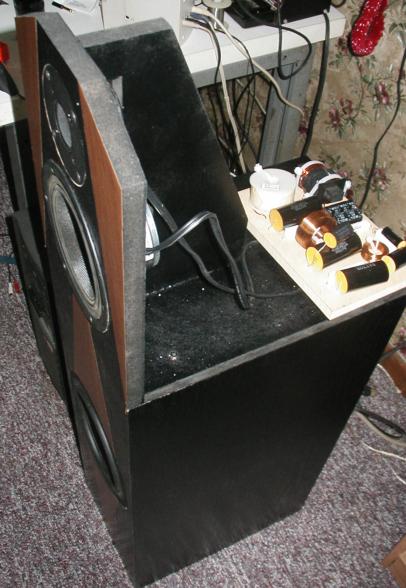
Crossover DesignThe crossover for the Dionysus speaker design is shown below. All drivers are filtered with 4th order Linkwitz-Riley slopes wtih crossover points of about 300 Hz and 2kHz. I spent about 2 months working on the crossovers for this design using various measurements but really relied on my ears when tweaking. I had tried using a lower woofer/mid crossover point but ran into a few problems. I found that the XG18 driver has a noticeable resonance near 300 Hz and this was more prominent with a lower crossover point. Also I found that lowering the crossover point caused the impedance to drop too low. So in the end I arrived at the topology and circuitry below. Although the crossover that I constructed was made of spare parts that I had, the lables on the plot below are based on parts available from Parts Express. Click the pic below for a full sized schematic.PerformanceThe frequency and impedance response plots are shown above. The response shown above is based on gated measurements from about 1 meter away. Despite the flatness of the response shown it took me several attempts to arrive at a response that sounded natural and balanced. I'm pretty happy with the outcome because unlike the Daedalus design, this one has a much deeper soundstage and perhaps a more neutral sound overall.The RS28A tweeter provides a pretty smooth top end but doesn't have quite as much sparkle as some of the fabric domes I've used. Like some of the other metal dome tweeters I've used, this one tends to emphasize more of the fundamental ring of an instrument such as a tambourine or ride cymbal but less of a splash that fabric domes tend to have. However, it has been said that this could be due to the lower distortion of the RS28A. Regardless, it blends fairly well with the XG18. The XG18 sounds quite a bit different in an open baffle configuration as compared to the boxed sound that I got when I used it in my Asterion cabinet. The midrange is pretty clear although a bit forward at times. Even though the midrange is a bit prominent and forward, the dipole configuration compensates and provides depth in this region. I suspect that if I used the XG18 in a closed back design with the same general frequency response the soundstage would be forward and flat. An added advantage of the prominent midrange along with the dipole setup is that it is much easier to distinguish multiple instruments in the midrange region. The RS225 works excellent as a bass driver and the ported configuration provides a very deep bass response. Some in room measurements reveal that they go deeper than the 30 Hz f3 indicated by the simulation. All three drivers seem to work well together. I've compared the sound to my Alpheus MkII design which revealed some of the differences. While the Alpheus MkII has a deep soundstage due to the frequency balance and a less forward midrange, the Dionysus also has a deep soundstage but in a different way. The midrange is a bit forward which makes instruments and vocals very easy to pick out but at the same time that region has depth due to the open back design. So the soundstage depth in the Dionysus design is less a function of the frequency response and more a function of the open back baffle. For some reason recordings that have a bit of reverb in them sound especially spacious. The funny thing about these speakers are that they are a bit picky about the source material but not in a way that I've heard before. Some speakers I've built only sound good with well recorded material. These are that way to a degree but I've found several recordings that I thought were on the harsh side with other speakers and they sound great with these. So even though they sound great with some recordings it is more of a factor of the frequency balance of the recording and not how well it was recorded. The problem that I've found is that it is difficult to predict which recordings might sound good with these speakers but when the right recording is found they really shine. It is tough to pick a winner between these and my Alpheus MkII design. Despite both design using obsolete drivers I have a feeling that it will be much easier to find a pair of used Vifa XG18 drivers which is why I posted this project. The Alpheus MkII design tends to be a bit more laid back in the midrange which is what gives them depth in the soundstage. The Alpheus MkII design is probably a better all around speaker because it is very tolerant of the recording quality and just about everything sounds good with them. The Dionysus on the other hand can be a bit pickier in terms of recording quality but in a way that isn't predictable. However, with the right recordings these speakers are a step above the Alpheus MkII and they can really amaze me. Even when a suboptimal recording is played through the Dionysus speaker they don't sound that bad. So if you can get a hold of some XG18 drivers or have an existing project using them, you might want to give this design a try. 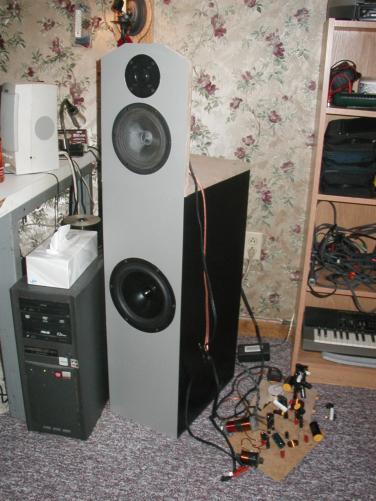 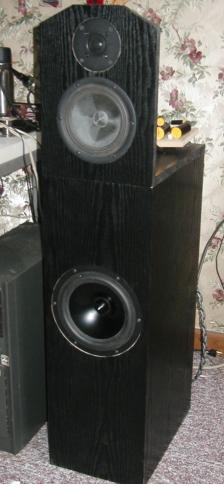 
|
